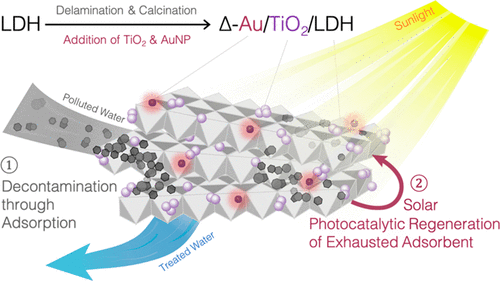当前位置:
X-MOL 学术
›
Environ. Sci. Technol.
›
论文详情
Our official English website, www.x-mol.net, welcomes your
feedback! (Note: you will need to create a separate account there.)
Enhanced Pollutant Adsorption and Regeneration of Layered Double Hydroxide-Based Photoregenerable Adsorbent.
Environmental Science & Technology ( IF 10.8 ) Pub Date : 2020-06-17 , DOI: 10.1021/acs.est.0c01812 Min-Jeong Suh 1 , Seunghyun Weon 1, 2 , Renyuan Li 3 , Peng Wang 4 , Jae-Hong Kim 1
Environmental Science & Technology ( IF 10.8 ) Pub Date : 2020-06-17 , DOI: 10.1021/acs.est.0c01812 Min-Jeong Suh 1 , Seunghyun Weon 1, 2 , Renyuan Li 3 , Peng Wang 4 , Jae-Hong Kim 1
Affiliation

|
Efforts to combine photocatalysts with organic and inorganic adsorbents in engineered composite materials have been pursued extensively to harness sunlight for a green, sustainable regeneration of exhausted adsorbent. Recent advances combining benchmark photocatalyst, titanium dioxide (TiO2), with an inorganic adsorbent, layered double hydroxides (LDHs), have shown potential for an inorganic adsorbent–photocatalyst system but faced critical limitations in realizing practical applications: low adsorption capacity and slow, inefficient photocatalytic regeneration. This study presents an enhanced TiO2/LDH based material that demonstrates a dramatically increased efficiency for both decontamination through adsorption and subsequent solar, photocatalytic regeneration. The combination of delamination and high temperature treatment of LDH is utilized to drastically enhance the adsorption capacity toward model contaminant Methyl Orange to 1450–1459 mg/g, which is even higher than most commercial and lab-synthesized carbon-based adsorbents. Light-active plasmonic nanoparticles are employed to increase the photocatalytic regeneration performance, and experimental results show that the synthesized composite material regains above 97% of its adsorption capacity for 5 cycles of regeneration and readsorption. Overall, the results of this study demonstrate potential for the development of inorganic multifunctional adsorbents that can harness a variety of chemical reactions without the loss of adsorptivity over long-term use.
中文翻译:

层状双氢氧化物基光致再生吸附剂的污染物吸附和再生增强。
已经广泛地进行了将光催化剂与有机和无机吸附剂结合在工程复合材料中的努力,以利用阳光来使耗尽的吸附剂实现绿色,可持续的再生。结合基准光催化剂二氧化钛(TiO 2)和无机吸附剂,层状双氢氧化物(LDHs)的最新进展显示出了无机吸附剂-光催化剂体系的潜力,但在实现实际应用时面临着关键限制:低吸附能力和缓慢,光催化再生效率低下。这项研究提出了增强的TiO 2基于/ LDH的材料,通过吸附以及随后的日光,光催化再生显示出极大的净化效率。LDH的分层和高温处理相结合,可将对模型污染物甲基橙的吸附能力大大提高至1450-1459 mg / g,甚至比大多数商业和实验室合成的碳基吸附剂还要高。光活性等离子体纳米颗粒被用于提高光催化再生性能,并且实验结果表明,合成的复合材料在5个再生和再吸收循环中恢复了其吸附能力的97%以上。总体,
更新日期:2020-07-21
中文翻译:

层状双氢氧化物基光致再生吸附剂的污染物吸附和再生增强。
已经广泛地进行了将光催化剂与有机和无机吸附剂结合在工程复合材料中的努力,以利用阳光来使耗尽的吸附剂实现绿色,可持续的再生。结合基准光催化剂二氧化钛(TiO 2)和无机吸附剂,层状双氢氧化物(LDHs)的最新进展显示出了无机吸附剂-光催化剂体系的潜力,但在实现实际应用时面临着关键限制:低吸附能力和缓慢,光催化再生效率低下。这项研究提出了增强的TiO 2基于/ LDH的材料,通过吸附以及随后的日光,光催化再生显示出极大的净化效率。LDH的分层和高温处理相结合,可将对模型污染物甲基橙的吸附能力大大提高至1450-1459 mg / g,甚至比大多数商业和实验室合成的碳基吸附剂还要高。光活性等离子体纳米颗粒被用于提高光催化再生性能,并且实验结果表明,合成的复合材料在5个再生和再吸收循环中恢复了其吸附能力的97%以上。总体,











































 京公网安备 11010802027423号
京公网安备 11010802027423号